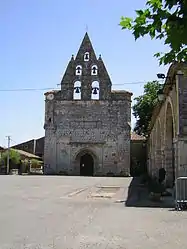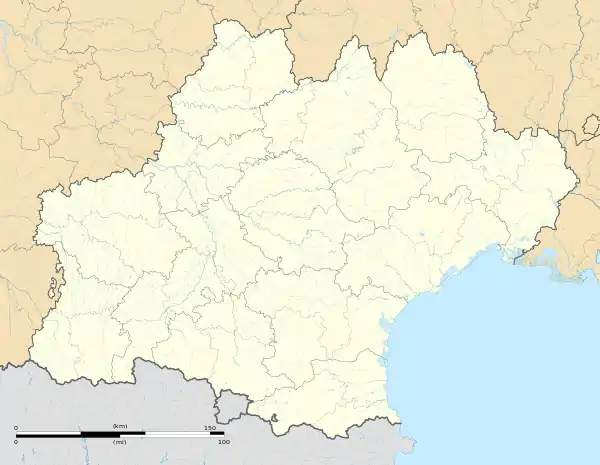Alan, Haute-Garonne
Alan (French pronunciation: [alɑ̃] ⓘ) is a commune in the Haute-Garonne department in southwestern France.
Alan | |
|---|---|
 The church in Alan | |
.svg.png.webp) Coat of arms | |
Location of Alan | |
 Alan  Alan | |
| Coordinates: 43°13′50″N 0°56′25″E | |
| Country | France |
| Region | Occitania |
| Department | Haute-Garonne |
| Arrondissement | Saint-Gaudens |
| Canton | Cazères |
| Intercommunality | Cœur et Coteaux du Comminges |
| Government | |
| • Mayor (2020–2026) | Francis Beausor[1] |
| Area 1 | 11.29 km2 (4.36 sq mi) |
| Population | 291 |
| • Density | 26/km2 (67/sq mi) |
| Time zone | UTC+01:00 (CET) |
| • Summer (DST) | UTC+02:00 (CEST) |
| INSEE/Postal code | 31005 /31420 |
| Elevation | 271–520 m (889–1,706 ft) (avg. 378 m or 1,240 ft) |
| 1 French Land Register data, which excludes lakes, ponds, glaciers > 1 km2 (0.386 sq mi or 247 acres) and river estuaries. | |
Geography
The commune is bordered by seven other communes: Bachas to the north, Terrebasse to the northeast, Marignac-Laspeyres to the east, Le Fréchet to the south, Aurignac to the southwest, Montoulieu-Saint-Bernard to the west, and finally by Benque to the northwest.
History
The village was established in the 11th century as a sauveté by the Knights of St John.[3]: 59–60 In the 13th century (1272), it was transformed into a bastide by Eustache de Beaumarchais.[4] Shortly afterwards Bertrand de Miramont, Bishop of the Comminges, established a residence there, expanded by subsequent bishops to become their winter palace.[5] The Bishops of Comminges ruled Alan without a feudal system, but with the peasants paying their tax to the church. In 1498, the county of Comminges passed to the King of France and taxes were collected by the Estates of Comminges (a type of local parliament).[3]: 97–136 After the French revolution, the palace and its gardens were declared national property and divided into eleven parts. Gradually these fell into disuse and the building was abandoned in the 19th century, although it has been extensively restored by recent owners.[6]
An earlier text dates the establishment of Alan, Haute-Garonne and its name back to the fifth century AD during the reign of Constantius III and his campaigns against the Visigoths in northern Hispania.[7] In 414 AD, the forces of Visigothic King Athaulf along with their Alan allies marched into southern Gaul in search of a place to settle. They gained control of Narbonne, Toulouse and Bordeaux before facing a stalemate at Bazas. At that point, Count Paulinus of Pella, who happened to a friend of the Alan leader, and who was inside the besieged town with his family,[7] managed to persuade the Alan chiefs to change their allegiance from the Visigoths and help successfully break the siege of Bazas. In exchange Paulinus promised the Alans land on which to settle.[8][9][10] The Goths, deprived of their Alan allies broke off the siege and through constant pressure by forces of Constantius, fled from southern Gaul, crossing the Pyrenees and entering Hispania in 415 AD.[11][12] Following this victory, emperor Constantius, as part of his plan to confine the Goths in Hispania, fulfilled the agreement between Paulinus and the Alans, arranging for the division of land between Toulouse and the Mediterranean, enabling the Alans to control coastal roads particularly the Via Domitia connecting Gaul with Hispania.[8] In this area, Alan military settlers or their descendants appear to have given their name to the towns including Alan but also Alénya, Alaigne and Lanet.[10]
Population
The inhabitants of the commune are called Alanais.
| Year | Pop. | ±% p.a. |
|---|---|---|
| 1968 | 267 | — |
| 1975 | 228 | −2.23% |
| 1982 | 259 | +1.84% |
| 1990 | 276 | +0.80% |
| 1999 | 299 | +0.89% |
| 2007 | 305 | +0.25% |
| 2012 | 316 | +0.71% |
| 2017 | 305 | −0.71% |
| Source: INSEE[13] | ||
References
- "Répertoire national des élus: les maires" (in French). data.gouv.fr, Plateforme ouverte des données publiques françaises. 13 September 2022.
- "Populations légales 2020". The National Institute of Statistics and Economic Studies. 29 December 2022.
- Souriac, René (2019). Petite Histoire du Comminges (in French). ISBN 978-2-35068-705-6. OCLC 1122793180.
- Charles Higounet (1986) Eustache de Beaumarchais et les bastides de Gascogne, dans Villes, sociétés et économies médiévales (Homenaje José María Lacarra), 1986, p600
- "History of the Bishops' Palace of Comminges".
- "The restoration of the Bishops' Palace of Comminges".
- Bachrach, Bernard S. (25 July 1973). A History of the Alans in the West. U of Minnesota Press. ISBN 978-0-8166-5699-8.
- Rist, Josef (31 December 2012), "Krisenerfahrung in der Zeit der Völkerwanderung: Paulinus von Pella und sein Lebensbericht (Eucharisticos Deo sub ephemeridis meae textu)", Patristik und Resilienz, DE GRUYTER, pp. 233–254, doi:10.1515/9783050059365.233, ISBN 978-3-05-005550-3, retrieved 13 February 2023
- Bachrach, Bernard S. (1967). "The Alans in Gaul". Traditio. 23: 476–489. doi:10.1017/s0362152900008849. ISSN 0362-1529. S2CID 152208072.
- Lot, Ferdinand (1928). "Du régime de l'hospitalité". Revue belge de philologie et d'histoire. 7 (3): 975–1011. doi:10.3406/rbph.1928.6536. ISSN 0035-0818.
- Thompson, E. A. (November 1956). "The Settlement of the Barbarians in Southern Gaul". Journal of Roman Studies. 46 (1–2): 65–75. doi:10.2307/297966. ISSN 0075-4358. JSTOR 297966. S2CID 162968524.
- Bachrach, Bernard S. (1969). "Another Look at the Barbarian Settlement in Southern Gaul". Traditio. 25: 354–358. doi:10.1017/s0362152900011028. ISSN 0362-1529. S2CID 151371666.
- Population en historique depuis 1968, INSEE